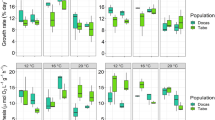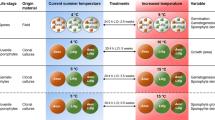Abstract
Environmental factors have long been shown to influence species distributions, with range limits often resulting from environmental stressors exceeding organism tolerances. However, these abiotic factors may differentially affect species with multiple life-history stages. Between September 2004 and January 2006, the roles of temperature and nutrient availability in explaining the southern distributions of two understory kelps, Pterygophora californica and Eisenia arborea (Phaeophyceae, Laminariales), were investigated along the coast of California, USA and the Baja California Peninsula, Mexico, by limiting either: (a) tissue nitrogen uptake and storage by adult sporophytes during periods of elevated temperature, and/or (b) production of embryonic sporophytes by microscopic gametophytes. Results suggest that while adult sporophytes of both species are tolerant of high temperatures and low nutrients, reproduction by their microscopic stages is not. Specifically, while E. arborea produced embryonic sporophytes at both 12 and 18°C, temperatures commonly observed throughout the southern portion of its range, P. californica produced sporophytes at 12 but not at 18°C. As a result, it appears that the southern distribution of P. californica, which ends in northern Baja California, Mexico, may be limited by temperature acting on its microscopic stages. In contrast, the ability of E. arborea’s microscopic and adult stages to tolerate elevated temperatures allows it to persist in the warmer southern waters of Baja California, as well as to the north along the California coast where both species co-occur.






Similar content being viewed by others
References
Abbott IA, Hollenberg GJ (1976) Marine algae of California. Stanford University Press, Stanford
Bolton JJ, Luning K (1982) Optimal growth and maximal survival temperatures of Atlantic Laminaria species (Phaeophyta) in culture. Mar Biol 66:89–94
Brown JH, Stevens GC, Kaufman DM (1996) The geographic range: size, shape, boundaries, and internal structure. Annu Rev Ecol Syst 27:597–623
Carney LT, Edwards MS (2006) Cryptic processes in the sea: a review of delayed development in the microscopic life stages of marine macroalgae. Algae 21:161–168
Chapman ARO, Craigie JS (1977) Seasonal growth in Laminaria longicruris—relations with dissolved inorganic nutrients and internal reserves of nitrogen. Mar Biol 40:197–205
Connell JH (1961) Influence of interspecific competition and other factors on fistribution of barnacle Chthamalus stellatus. Ecology 42:710–723
Dayton PK (1985) Ecology of kelp communities. Annu Rev Ecol Syst 16:215–245
Dayton PK, Tegner MJ, Parnell PE, Edwards PB (1992) Temporal and spatial patterns of disturbance and recovery in a kelp forest community. Ecol Monogr 62:421–445
Dayton PK, Tegner MJ, Edwards PB, Riser KL (1999) Temporal and spatial scales of kelp demography: the role of oceanographic climate. Ecol Monogr 69:219–250
Dean TA, Jacobsen FR (1984) Growth of juvenile Macrocystis pyrifera (Laminariales) in relation to environmental factors. Mar Biol 83:301–311
Denny M, Wethey D (2001) Physical processes that generate patterns in marine communities. In: Bertness MD, Gaines SD, Hay ME (eds) Marine community ecology. Sinauer Associates, Sunderland, pp 3–37
Dieck IT (1993) Temperature tolerance and survival in darkness of kelp gametophytes (Laminariales, Phaeophyta)—ecological and biogeographical implications. Mar Ecol Prog Ser 100:253–264
Edwards MS, Estes JA (2006) Catastrophe, recovery and range limitation in NE Pacific kelp forests: a large-scale perspective. Mar Ecol Prog Ser 320:79–87
Edwards MS, Hernandez-Carmona G (2005) Delayed recovery of giant kelp near its southern range limit in the North Pacific following El Nino. Mar Biol 147:273–279
Foster MS, Schiel DR (1985) The ecology of giant kelp forests in California: a community profile. US Fish Wildl Serv Biol Rep 85:1–152
Gaylord B, Denny MW (1997) Flow and flexibility. I. Effects of size, shape, and stiffness in determining wave forces on the stipitate kelps Eisenia arborea and Pterygophora californica. J Exp Biol 200:3141–3164
Gaylord B, Gaines SD (2000) Temperature or transport? Range limits in marine species mediated solely by flow. Am Nat 155:769–789
Gerard VA (1982) Growth and utilization of internal reserves by the giant kelp Macrocystis pyrifera in a low-nitrogen environment. Mar Biol 66:27–35
Gerard VA (1984) Physiological effects of El Nino on giant kelp in southern California. Mar Biol Lett 5:317–322
Gerard VA (1990) Ecotypic differentiation in the kelp Laminaria saccharina—phase specific adaptation in a complex life cycle. Mar Biol 107:519–528
Henley WJ, Dunton KH (1997) Effects of nitrogen supply and continuous darkness on growth and photosynthesis of the arctic kelp Laminaria solidungula. Limnol Oceanogr 42:209–216
Hernandez-Carmona G, Robledo D, Serviere-Zaragoza E (2001) Effect of nutrient availability on Macrocystis pyrifera recruitment and survival near its southern limit off Baja California. Bot Mar 44:221–229
Hochachka PF, Somero GN (2002) Biochemical adaptation: mechanisms and process in physiological evolution. Oxford University Press, New York
Hoffmann AA, Blows MW (1994) Species borders—ecological and evolutionary perspectives. Trends Ecol Evol 9:223–227
Hofmann GE, Burnaford JL, Fielman KT (2005) Genomics-fueled approaches to current challenges in marine ecology. Trends Ecol Evol 20:305–311
Holbrook SJ, Schmitt RJ, Stephens JS (1997) Changes in an assemblage of temperate reef fishes associated with a climate shift. Ecol Appl 7:1299–1310
Jackson GA (1977) Nutrients and production of giant kelp, Macrocystis pyrifera, off southern California. Limnol Oceanogr 22:979–995
Kinlan BP, Graham MH, Sala E, Dayton PK (2003) Arrested development of giant kelp (Macrocystis pyrifera, Phaeophyceae) embryonic sporophytes: a mechanism for delayed recruitment in perennial kelps? J Phycol 39:47–57
Kopczak CD, Zimmerman RC, Kremer JN (1991) Variation in nitrogen physiology and growth among geographically isolated populations of the giant kelp, Macrocystis pyrifera (Phaeophyta). J Phycol 27:149–158
Ladah LB, Zertuche-Gonzalez JA, Hernandez-Carmona G (1999) Giant kelp (Macrocystis pyrifera, Phaeophyceae) recruitment near its southern limit in Baja California after mass disappearance during ENSO 1997–1998. J Phycol 35:1106–1112
Matson PG (2006) Physical processes affecting the distribution and morphology of two understory kelps across a latitudinal gradient. MS Thesis. San Diego State University, CA
Parmesan C (1996) Climate and species’ range. Nature 382:765–766
Reed DC (1988) Variation in algal dispersal and recruitment: the importance of episodic events. Ecol Monogr 58:321–335
Reed DC (1990) An experimental evaluation of density dependence in a subtidal algal population. Ecology 71:2286–2296
Reed DC, Foster MS (1984) The effects of canopy shading on algal recruitment and growth in a giant kelp forest. Ecology 65:937–948
Reed DC, Ebeling AW, Anderson TW, Anghera M (1996) Differential reproductive responses to fluctuating resources in two seaweeds with different reproductive strategies. Ecology 77:300–316
Reed DC, Schroeter SC, Raimondi PT (2004) Spore supply and habitat availability as sources of recruitment limitation in the giant kelp Macrocystis pyrifera (Phaeophyceae). J Phycol 40:275–284
Roberson LM, Coyer JA (2004) Variation in blade morphology of the kelp Eisenia arborea: incipient speciation due to local water motion? Mar Ecol Prog Ser 282:115–128
Root T (1988) Environmental factors associated with avian distributional boundaries. J Biogeogr 15:489–505
Schiel DR, Steinbeck JR, Foster MS (2004) Ten years of induced ocean warming causes comprehensive changes in marine benthic communities. Ecology 85:1833–1839
Sjøtun K, Gunnarsson K (1995) Seasonal growth pattern of an Icelandic Laminaria population (section Simplices, Laminariaceae, Phaeophyta) containing solid and hollow-stiped plants. Eur J Phycol 30:281–287
Spalding H, Foster MS, Heine JN (2003) Composition, distribution, and abundance of deep-water (>30 m) macroalgae in central California. J Phycol 39:273–284
Stevens GC (1989) The latitudinal gradient in geographical range: how so many species coexist in the tropics. Am Nat 133:240–256
Underwood AJ (1997) Experiments in ecology. Cambridge University Press, New York
Zacherl D, Gaines SD, Lonhart SI (2003) The limits to biogeographical distributions: insights from the northward range extension of the marine snail, Kelletia kelletii (Forbes, 1852). J Biogeogr 30:913–924
Zimmerman RC, Kremer JN (1984) Episodic nutrient supply to a kelp forest ecosystem in Southern California. J Mar Res 42:591–604
Acknowledgements
We thank L. Carney, D. Cie, B. Critser, S. Fejtek, C. Loflen, T. Mai, R. Mothokakobo, A. Steyers, B. Stidium, M. Tamburro, and L. Thurn for their assistance in both the field and in the laboratory. This study is part of P. Matson’s MS thesis. Funding for this work was provided by grants to M. Edwards provided by the National Geographic Society (7540-03) and National Atmospheric and Space Administration (IDS/03-0000-04447).
Author information
Authors and Affiliations
Corresponding author
Additional information
Communicated by J.P. Grassle.
Rights and permissions
About this article
Cite this article
Matson, P.G., Edwards, M.S. Effects of ocean temperature on the southern range limits of two understory kelps, Pterygophora californica and Eisenia arborea, at multiple life-stages. Mar Biol 151, 1941–1949 (2007). https://doi.org/10.1007/s00227-007-0630-3
Received:
Accepted:
Published:
Issue Date:
DOI: https://doi.org/10.1007/s00227-007-0630-3




